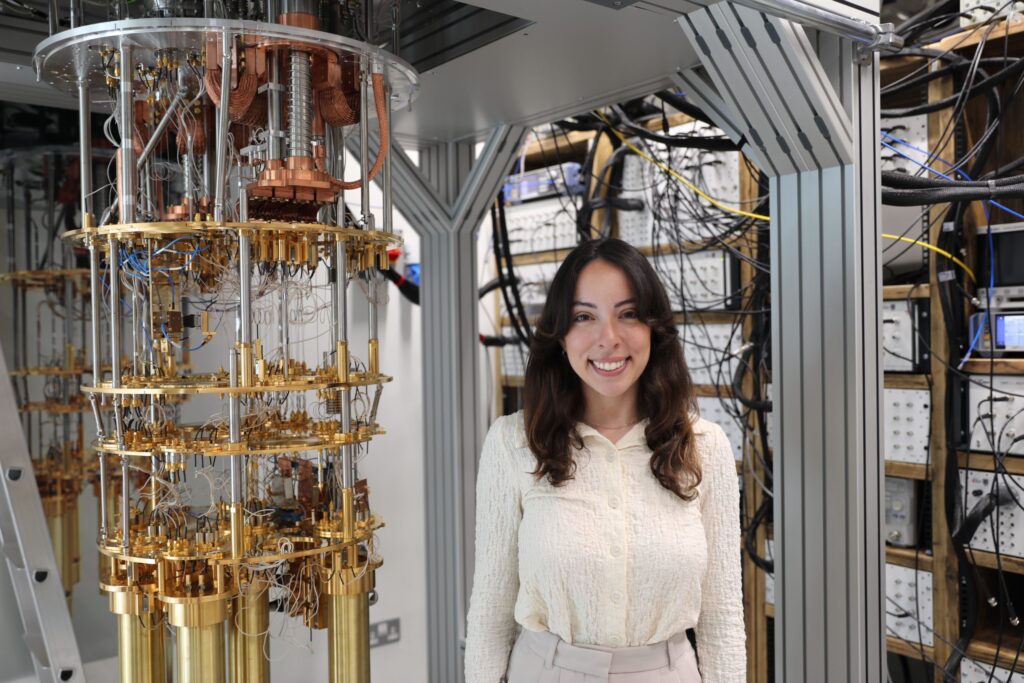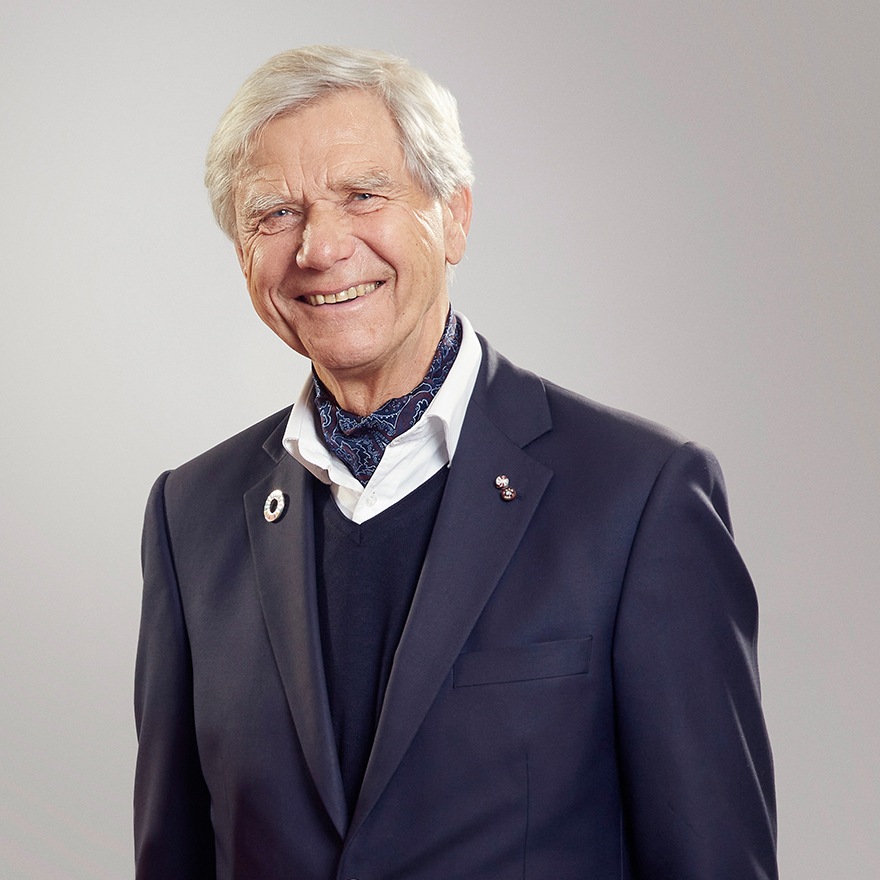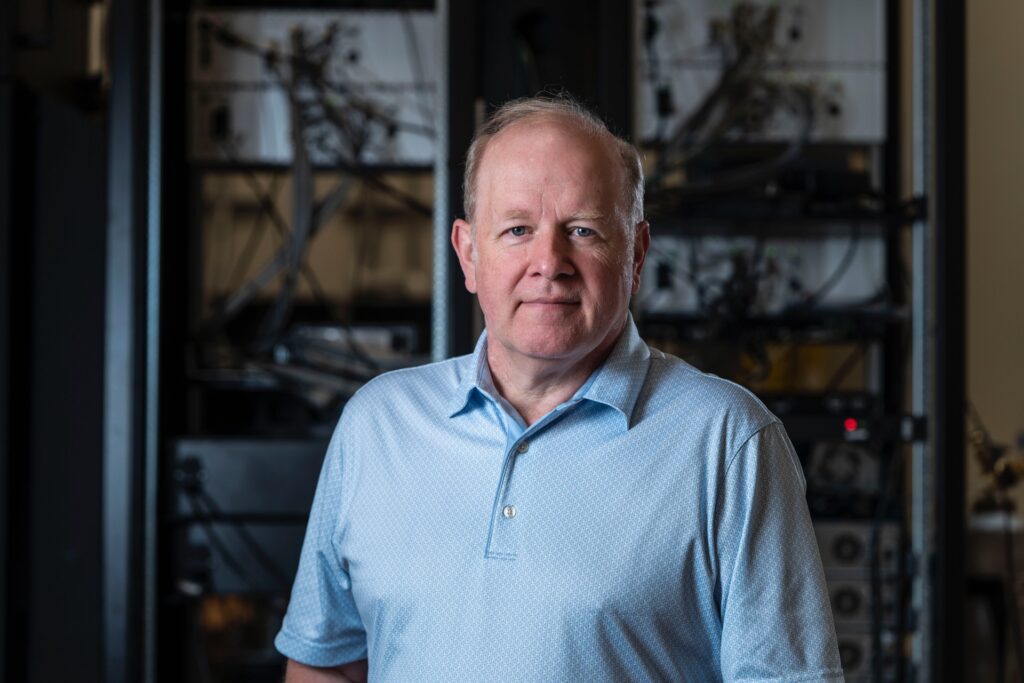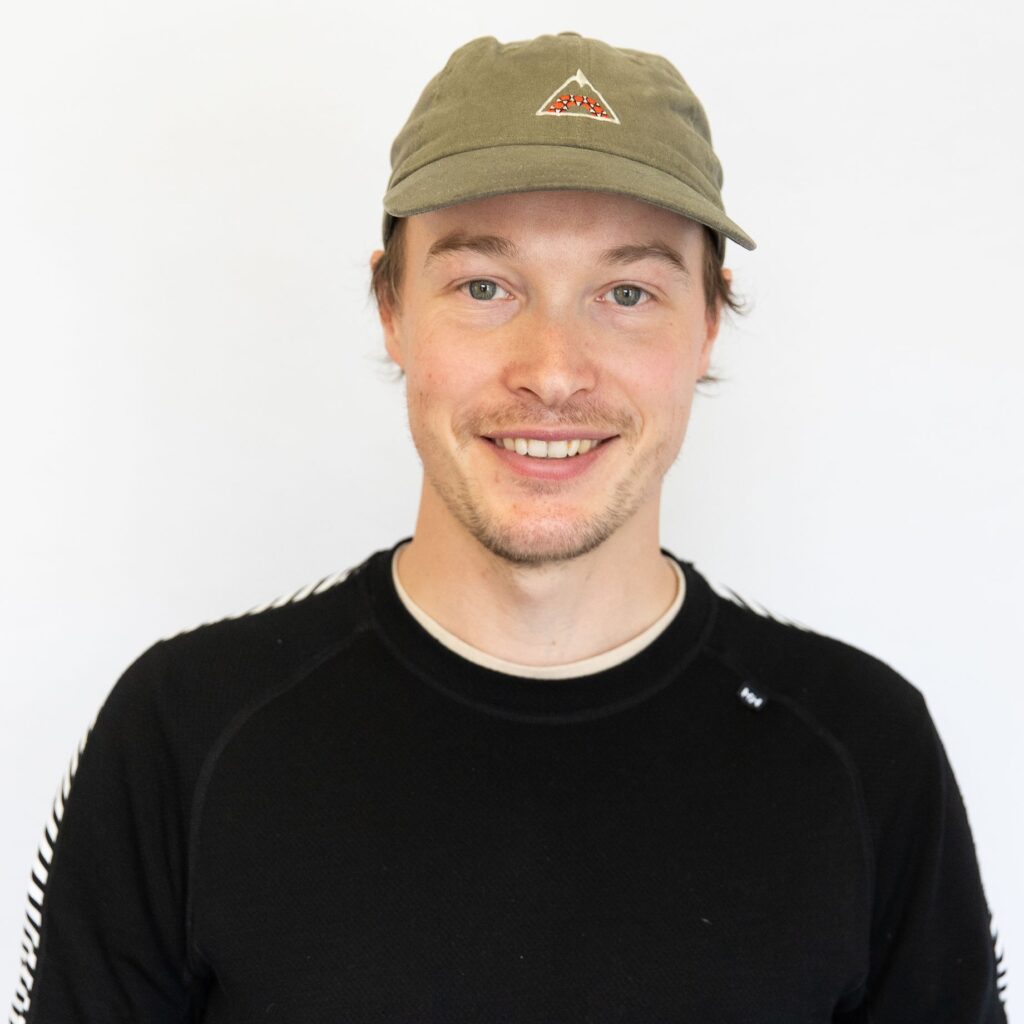Artificial Intelligence
Future Telecoms
Quantum
Future telecoms 2025 to 2026: from faster networks to thinking infrastructure
Reading time: 7 mins
There are currently five technologies involved in the race to create the world’s first useful quantum computer. Here we explore the science behind the front-runners, and get Hermann Hauser’s take on who the eventual winner might be…
McKinsey claims that the quantum computing market could be worth $2 trillion within ten years, with the company predicting that there will be up to 5,000 operational quantum computers by 2030. For context, this would put quantum computing on a par with the global mining and tourism industries, which currently sit at $2.5tn and $2tn respectively.
The justification behind these bullish predictions is the fact that quantum computers are likely to benefit many sectors, with the worlds of finance, energy, transport, logistics, medicine, automotive, travel, insurance, media, and technology all expected to see huge transformations. However, these are currently hypothetical, as no company has yet developed what we might refer to as a “useful” quantum computer.

Using the Technology Readiness Levels (TRL) system – designed by NASA in the 1970s – business consultancy Arthur D. Little spoke to 59 quantum computing experts and asked them for their opinion on where quantum technologies currently sit.
“Quantum computing technology development is generally assessed as being at the stage of lab-scale proof of concept; in other words, technology readiness level (TRL) 3 or 4,” the report claims. However, although 65% rated quantum computing at TRL 4 or less today, 75% of experts said that they expect quantum computing to reach TRL 8 or 9 by 2032.
The ultimate goal within quantum computing is to build viable systems that can produce large numbers of high-quality qubits. Many qubit modalities have already shown that they can create working machines, and some have managed to meet a high-quality benchmark. But the real challenge is scaling up the qubit count whilst keeping error rates low.

“Within this decade, I think it is likely that we will see a commercially-useful quantum computer, although exactly when depends as much on the development of suitable algorithms as it does on hardware advancements,” April Carniol, programme director at Quantum Motion, tells us. “Currently, an error-corrected quantum computer might require hundreds of thousands of qubits to address commercially viable problems. However, new algorithmic approaches are reducing this regularly.”
Unlike a traditional computer that uses bits to store data, quantum computers use alternatives called “qubits”. Qubits operate according to the laws of quantum mechanics, using something called entanglement to deliver exponentially faster results when trying to solve complex algorithmic problems. There are currently five different qubit technologies in the running: superconducting; trapped ion; photonic; neutral atom; and silicon quantum dot.

“It takes me back many years, to the transistor fight we had between PMOS and NMOS,” explains Hermann Hauser, who co-founded Acorn Computers in 1978, helped develop the ARM processor, and is one of the world’s leading investors at Amadeus Capital Partners. “PMOS was the positively charged transistor. NMOS was the negatively diluted transistor. And these were the two camps that fought it out. And then there was this CMOS transistor, which nobody really believed in, because it was far too complex, and was a complementary method semiconductor. And yet CMOS won out.
“And so I wonder if we have a repeat performance going on at the moment, where we’ve got five ways of creating qubits in the running,” Hausser says.
While experts are still undecided over which technologies will succeed, what they can all agree on is the myriad use cases that quantum computing will present, like solving complex optimisation problems in areas such as drug discovery, logistics, and finance. And with so many use cases it’s unlikely that an early winner will emerge.
“It will not be a zero-sum game in the near future,” says Justin Ging, chief product officer at Atom Computing. “There is currently a race for quantum computers to be able to perform computations that provide economic value, and the first quantum computers that prove this ability will secure a large fraction of the market for some time.

“However, until universal fault-tolerant quantum computing resources are widely available, different modalities can provide particular advantages for specific applications, so the market can stay diversified for the foreseeable future,” Ging continues.
Quantum computers will also enable nuclear, atomic, and molecular modelling at the quantum level, delivering better research in materials science, drug discovery, and energy applications. And, perhaps most pressing for governments around the planet, is the issue of post-quantum security (with quantum computers expected to easily crack existing encryption methods).
With each of the leading qubit technologies offering something unique, five out of the six quantum experts that we spoke to for this report said that it was unlikely to be a winner-takes-all scenario.
Superconducting is the most widely-used technology for quantum computers today, with Google and IBM Q amongst the biggest players (others include Rigetti, QuTech, QCI, IQM, and Origin Quantum). And one of the most appealing aspects of superconducting is its scalability, thanks to the use of well-established semiconductor fabrication technologies, which in turn enable greater scaling.
“This is critical, because for a quantum computer to be useful, a large number of qubits is essential,” explains Michael Bruce, public relations manager at IQM Quantum. “In addition, superconducting qubits are compatible with existing microwave and cryogenics technologies, such as cryostats, cabling, amplifiers, and sensors, and are also remarkably designable and tunable. Currently, we are actively exploring potential use cases in machine learning, cybersecurity, route optimisation, quantum sensor simulation, chemistry, and pharmaceutical research.”
On the downside, superconducting has relatively short coherence time compared to other platforms, which is in some way mitigated by fast gate operation. And superconducting quantum computers are also bulky, require extreme cooling, and are harder than some alternative quantum technologies to scale up.
Companies such as IonQ, AQT, Quantinuum, Oxford Ionics, and Universal Quantum use trapped ions as qubits, which they say provides the best gate fidelity results, and a unique scaling opportunity. Of all these companies, IonQ came to prominence at the end of 2021, as the first pure-play quantum computing company to go public.
“Looking forward, I expect other types of quantum systems to still hold up well for smaller calculations where error is less of a factor as it doesn’t compound much,” says Peter Chapman, CEO, president, and chairman of the board at IonQ. “However, it’s likely we’ll see the most cutting-edge and complex problems run on trapped ion systems like our own. Real-world users are starting to realise that not all technologies are the same – a point that becomes all the more apparent as systems scale.”
However, it isn’t all good news in the trapped ion camp. Like superconducting, trapped ions can suffer with decoherence, and they are also historically inefficient, with one study claiming that only 1-2% of computation time is spent on quantum operations, saying “the rest was spent shuttling the ions and cooling them”.

“On the technology side we use photons, whilst everyone else uses matter – and there are lots of different ways of using matter: electrons, atoms, super qubits, whatever,” explains Pete Shadbolt, co-founder and chief scientific officer at PsiQuantum.

PsiQuantum is one of a number of companies, including ORCA Computing, XANADU, and QuiX Quantum that’s looking towards light for inspiration, enabling them to claim a huge point of difference when compared to other qubit technologies.
“Photons don’t feel heat, and we just have an intrinsic advantage, working with light instead of matter,” Shadbolt tells us. “The other advantage that we always liked in the beginning was manufacturability. So the fact is that we could use these existing semiconductor manufacturing processes to make the chips that manipulate the photons. And that we could do that without profound reinvention of the semiconductor manufacturing. It took a trillion dollars to build the semiconductor industry.”
As with other qubit technologies, photonic quantum computing requires extremely low temperatures to operate, and this could pose issues when it comes to scaling. But some of these will be alleviated, Shadbolt says, by connecting machines over existing optical fibre.
The neutral atom community has recently developed competitive single-qubit and two-qubit gate fidelities. And, in contrast to other modalities, the neutral atom approach has the flexibility to perform quantum operations in parallel, and that parallelisation provides a large speedup of overall computation. Neutral atom systems can also run at room temperature, have “perfect” qubits (using individual atoms), and can support tens of thousands of qubits on a single computer.
“We recently showed how our second-generation systems can hold more than 1,200 qubits continuously, and the same technology can be used to aggressively continue scaling the number of qubits,” Ging tells us. “The current system is room-sized, and its power consumption is small enough to easily be placed in an office building… in big contrast to other approaches where many modules of small quantum cores must be replicated across football field-sized facilities.”
One of the challenges of neutral atoms, compared to superconducting quantum computing, is the relative speed of the system. Manipulating atoms and reading out results takes more time than pure electrical circuits. But parallelisation could potentially free up sufficient overhead to perform complex quantum error correction, without being limited by qubit coherence.
Silicon spin / quantum dot qubits have favourable physical properties (made of nanometer-sized crystalline silicon), enabling long coherence times and high fidelities. Additionally, they can feasibly scale up to fabricating millions of qubits using existing semiconductor technology, which many believe will be a requirement for building a fault-tolerant quantum computer.
“Similar to the silicon chips in our phones containing billions of transistors, we are developing compact quantum processors containing quasi-transistors – small (less than 100 nanometre footprint), high-density, and fast spin qubits in semiconductor quantum dots – fabricated using standard CMOS processes,” says Carniol.
While silicon quantum dot technology can deliver a processor with a large number of qubits, it is not enough, because the extreme temperatures that these qubits require to operate cause issues in other areas.
“We also need corresponding electronics to be able to control and readout each individual qubit, which is a very challenging, universal problem,” says Carniol. “Most quantum systems require ultra-cold temperature environments to operate, but existing solutions operate outside the cryostat, at room temperature, and cannot efficiently deliver signals to and from the quantum processor.”
The State of Quantum 2024 Report from IQM reveals that quantum computing has been resilient to overall downturns in the global economy, thanks in no small part to massive public investment. According to the report, over 30 governments have committed to more than $40 billion in public funding commitments to quantum technologies, to be deployed over the next 10 years.
“We’ve been encouraged by the increase in investment by the US government in quantum information science, driven by such initiatives as the National Quantum Initiative and the CHIPS and Science Act,” Chapman says.
Government organisations around the world have already invested billions of dollars in quantum computing ($42 billion, according to McKinsey). And whilst China is the clear front-runner when it comes to national investment of $15 billion in quantum, other countries are also making big investments (Germany $5.2bn, the UK $4.3bn, the US $3.8bn, and South Korea $2.4bn).
“There is an absolutely remarkable effect that I’ve never seen in technologies before, that there are billions of dollars now available in government funding that is going into quantum computing,” Hauser tells us. “It’s because they’re all terrified, and they want to have a quantum computer when quantum computers are powerful enough to crack RSA 2048.
“So we have – for the first time ever, that I can remember – we have an artificial government market before there is a real one. And hopefully that will bridge the gap until we get to real applications, ones that a company is going to pay money for.”

Start-up funding coming from venture capital has dropped since 2021, and quantum computing has not been immune to this; according to the State of Quantum 2024 report, VC investment for quantum start-ups fell from $2.2 billion in 2022 to $1.2 billion in 2023. However, quantum computing performed better than other sectors, and there’s a huge amount of optimism amongst those working in the field.
“It’s an incredibly vibrant ecosystem because quantum computing is a field where the complexities of the technology often necessitate partnerships between academia, industry, and government entities,” says Carniol. “This collaborative funding environment helps in pooling resources and expertise. We have gained significantly from the various funding sources such as grants, procurements, and venture capital funding as we have built Quantum Motion.”
Research amongst quantum computing experts has found that, when asked which was the most promising qubit technology, 39% opted for electrons, 35% chose atoms, and 26% photons. And – like those experts – investors are still erring on the side of caution, a point summed up by Hausser’s wonderfully non-committal response, when asked which technology will triumph.
“I think that you currently have superconducting qubits and trapped ions out in front,” Hauser tells us. “Then there is a new belle du jour, which is neutral atoms. So the jury is still very much out. But, although the superconducting qubits and trapped ions have the lead right now, I believe that photonic and silicon spin technology might well be the long-term winners – or maybe a combination of the two.”

Dan Oliver is a UK-based technology and design journalist with 25 years of experience. Dan has produced content for numerous brands and publications including The Sunday Times, TechRadar, Wallpaper* magazine, Amazon, Microsoft, Meta, and more.
Quantum
Reading time: 10 mins
Quantum
Reading time: 10 mins
Quantum
Reading time: 11 mins
Robotics
Reading time: 1 mins
Quantum
Reading time: 3 mins